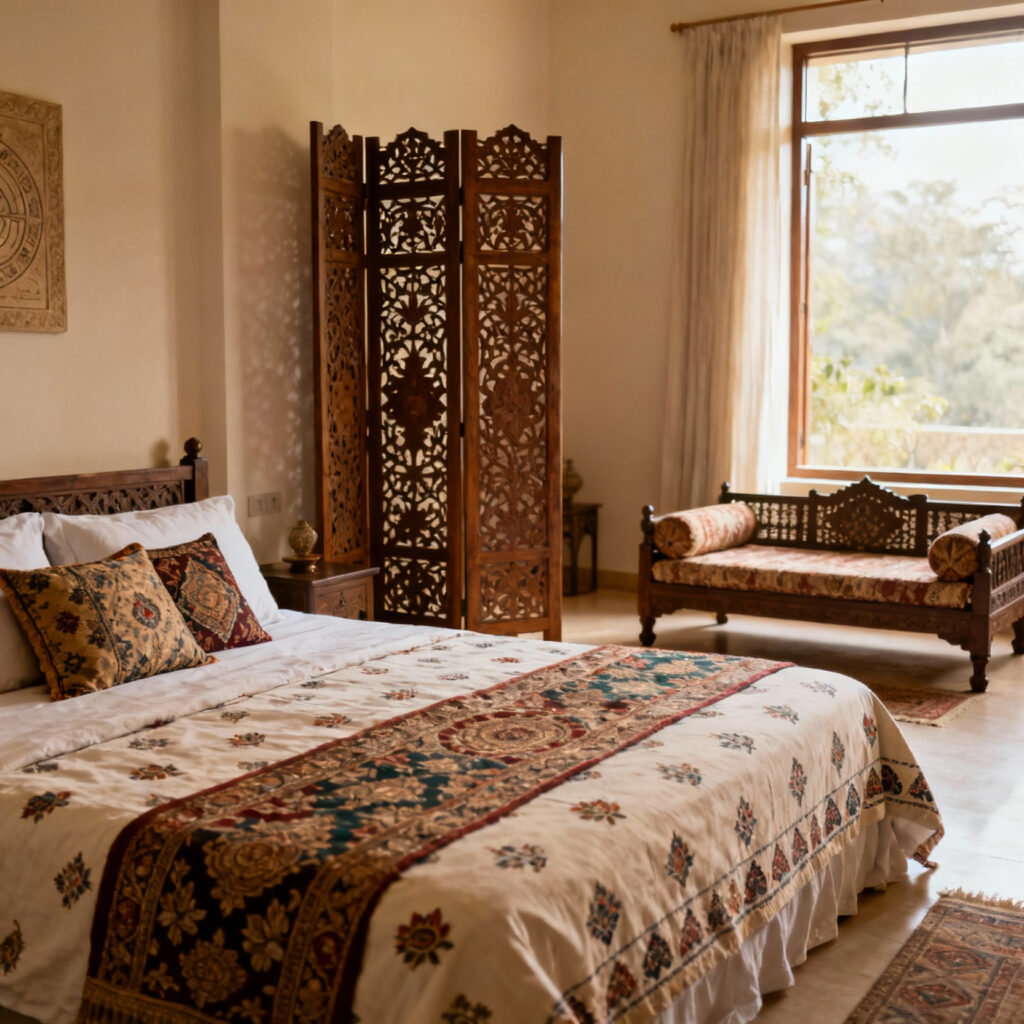Since the age of the Maharajas, the Indian bedroom, or shayan kaksha, has served as far more than a place for sleep; it has been a deeply personal sanctuary for quiet contemplation, artistic expression, and intimate connection. This space has evolved from the opulent, silk-draped chambers of ancient palaces to the thoughtfully curated retreats in modern homes. Today’s most sophisticated interiors understand this dual principle: a bedroom must be both a feast for the senses and a balm for the soul. The 20 principles that separate a home infused with soul-stirring cultural depth from a merely decorated space haven’t changed in centuries. It’s all about weaving stories, celebrating artistry, and creating a haven that feels like a true reflection of you.
This isn’t about recreating a museum piece. Oh, no. It’s about a vibrant conversation between the past and the present, where ancient wisdom and contemporary aesthetics dance together. It’s about inviting the warmth, color, and unparalleled craftsmanship of Indian design into your modern life with grace and confidence. Let’s embark on this journey together and transform your bedroom into a sanctuary that not only looks magnificent but also feels profoundly, authentically yours.
The Axiomatic Foundations: Blueprinting Tranquil Spatial Alchemy (Part 1)
Before we can even think about the magnificent textiles or vibrant colors, we must create a canvas of calm. These first principles are the bedrock of a serene space, drawing on ancient wisdom to establish an environment that feels inherently peaceful and balanced. This is where we lay the groundwork for our cultural sanctuary, ensuring the very bones of the room radiate tranquility.
1. Embrace Holistic Spatial Planning Through Vastu Shastra or Feng Shui Principles
Let’s start with the unseen—the energy of the room itself. Long before interior design was a formal profession, ancient sciences like Vastu Shastra in India and Feng Shui in China offered profound blueprints for creating spaces that feel just… right. These aren’t rigid rules but gentle guides for arranging your room in harmony with natural energy flows. Think of it as choreographing a beautiful dance between you and your environment.
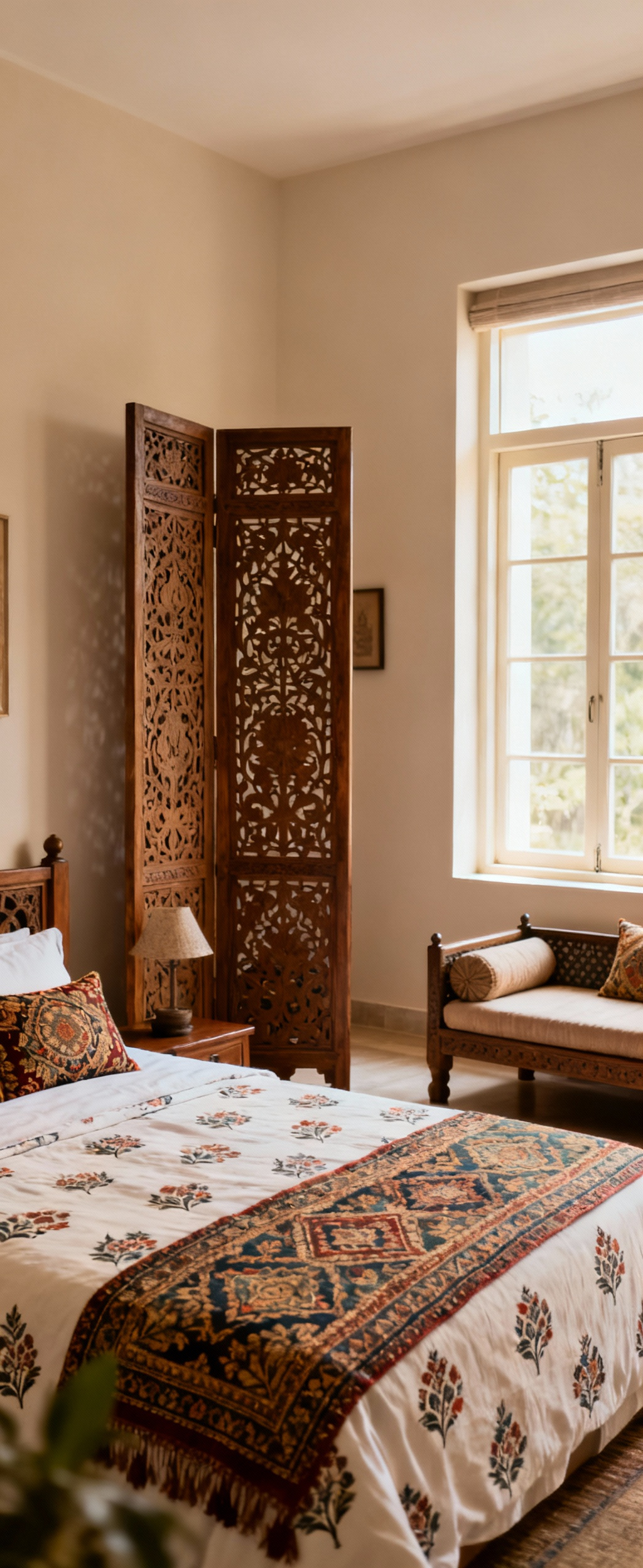
For your bedroom inspirations decor, this means placing your bed in what’s called a “commanding position.” You want a solid wall behind you for support—a feeling of being held and protected—but not directly in line with the doorway, which can feel unsettling. In my indo-contemporary fusion specialist practice, I often suggest locating the master bedroom in the southwest corner, a Vastu principle said to promote stability. But honestly, it’s the intention that matters most. Even simple acts, like clearing clutter from under the bed to let energy flow freely or ensuring you have clear pathways, can dramatically shift the room’s atmosphere. You’re not just arranging furniture; you’re creating a foundation for deep, restorative rest.
2. Calibrate Circadian Rhythms with Adaptive Layered Illumination Systems
Lighting is the unsung hero of bedroom design. It’s the silent conductor of our daily rhythm, capable of either jarring our senses or lulling us into peaceful slumber. A truly sophisticated lighting scheme works with our natural body clock, not against it. The magic lies in creating layers of light that you can adapt throughout the day. Your main ambient light should be on a dimmer—non-negotiable!—allowing you to shift from bright and energizing in the morning to a warm, sunset-like glow in the evening. This gentle transition signals to your body that it’s time to wind down.
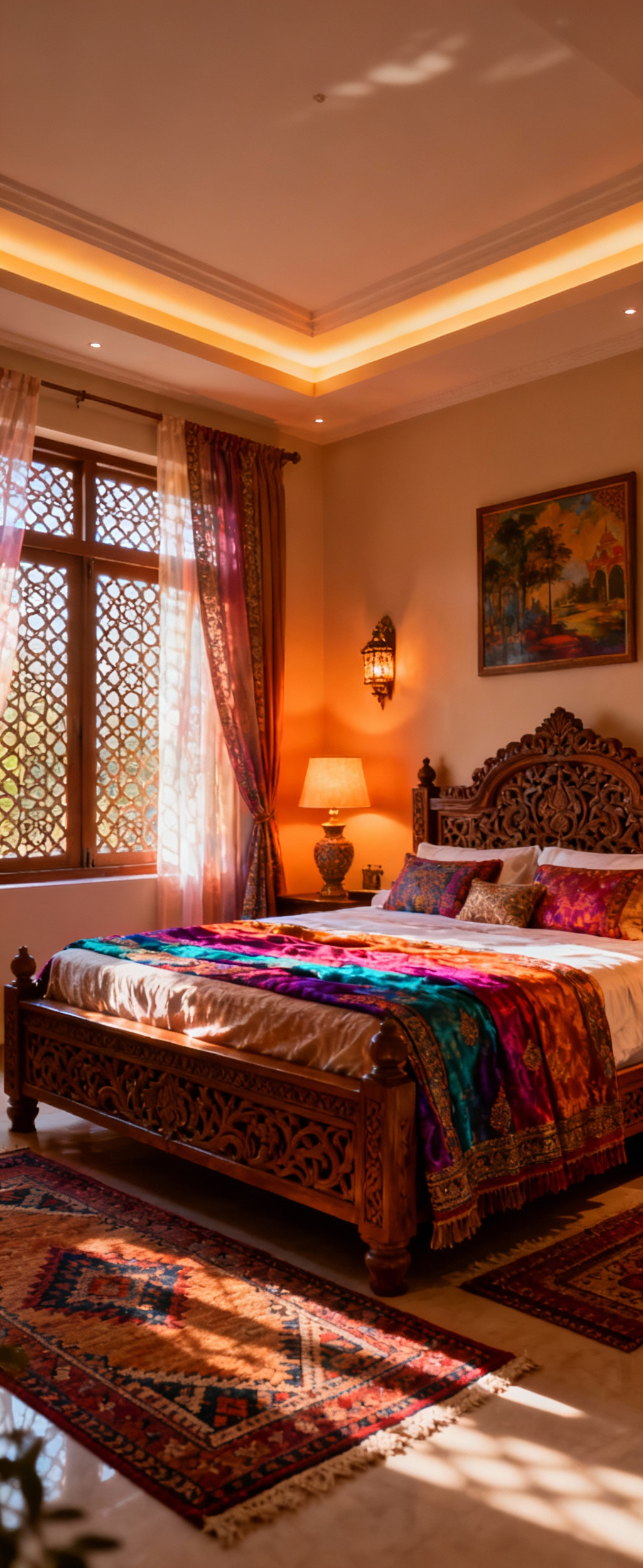
Then, you have your task lighting, like the elegant lamp by your bedside for that last chapter of a good book. Here’s a tip: choose a bulb with a warm temperature to avoid that stimulating blue light. Finally, the accent lighting. This is where the artistry comes in. Perhaps it’s a soft glow from behind a carved wooden screen, a single dramatic uplight on a beautiful plant, or a string of tiny Diya-like lights woven through a canopy. What I’ve seen in my professional experience is that a space with layered, warm light doesn’t just feel cozier; it actively supports better sleep and a more peaceful state of mind.
3. Curate a Restorative Chromatic Palette Infused with Culturally Resonant Hues
Color is emotion. In a bedroom, it’s the whisper that soothes you to sleep and the gentle greeting that wakes you. When we talk about an Indian-inspired palette, many imagine a riot of intense color, but the secret to a serene sanctuary lies in a more nuanced approach. Think of the soft, sun-faded hues of a Jaipur palace wall—creamy whites, earthy terracotta, gentle ochres, and the palest of sky blues. These create a calming, expansive backdrop.
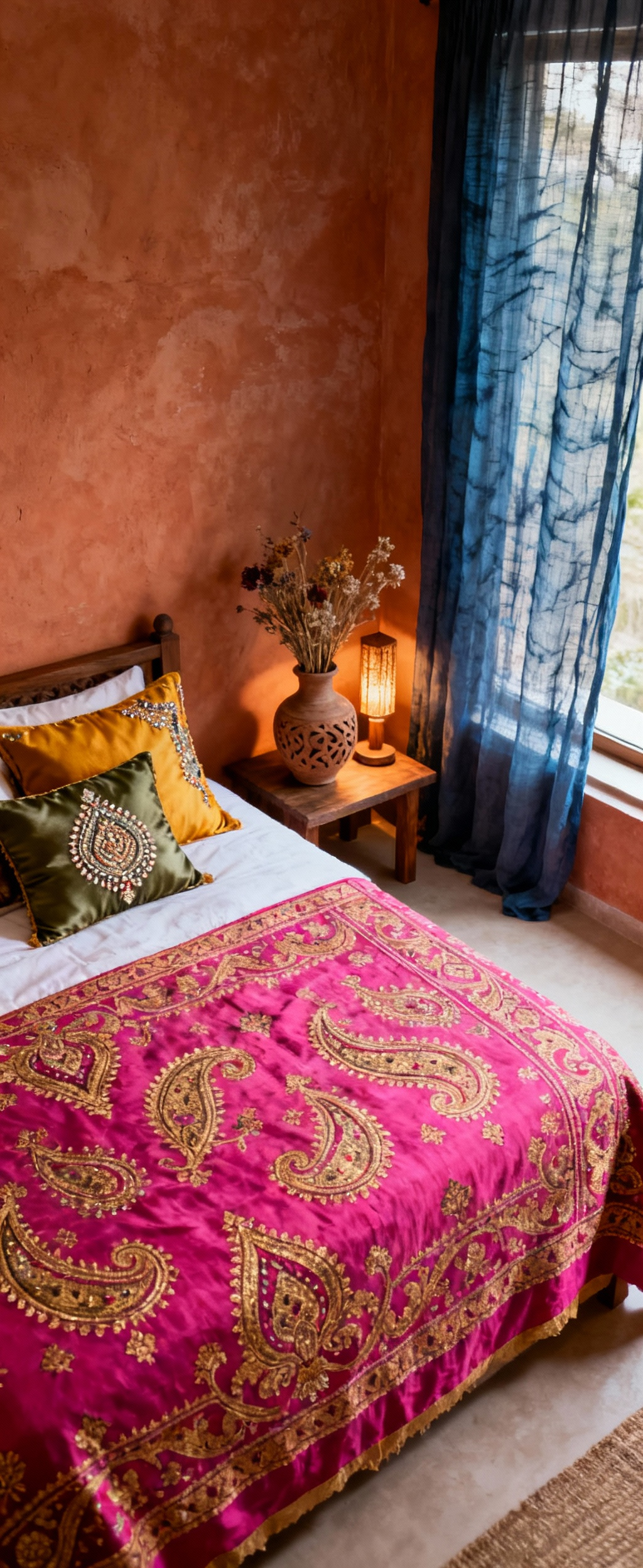
This serene canvas is where you can then introduce culturally resonant accent colors. And what glorious colors they are! A single cushion in brilliant saffron, a color of spirituality and celebration. The deep indigo of a block-printed throw, echoing centuries of dyeing traditions. Or the rich teal of a peacock feather, subtly woven into a pattern. In my experience with Indian Art Integration and Color Psychology, the key is balance. You don’t need to paint a whole wall magenta to make a statement. A thoughtfully placed splash of vibrant, meaningful color against a tranquil background feels confident, rich, and utterly sophisticated, transforming your room into a living piece of art.
4. Implement Tactile Layering for Sensory Depth and Haptic Richness
A sanctuary should engage all the senses, and touch is one of the most powerful. Layering different textures is how we build a room that feels as good as it looks—a space that invites you to reach out and connect. It’s about creating a rich, haptic landscape that’s an absolute joy to live in. Imagine the cool, smooth feel of silk pillows resting against the soft, nubbly texture of a hand-loomed cotton duvet. The contrast is divine.
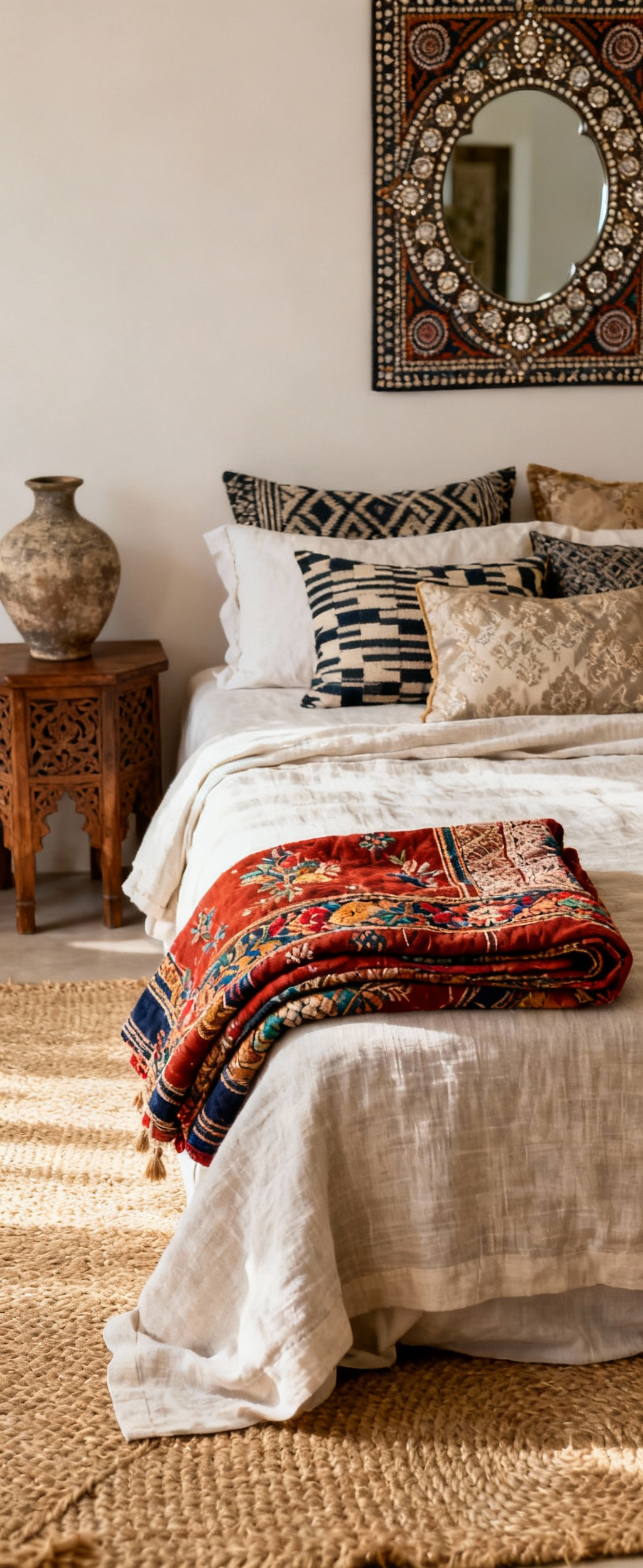
India’s textile heritage offers an incredible vocabulary of textures to play with. Think of the rustic comfort of a thick Kantha quilt, its surface rippling with tiny hand-stitches, draped over the crisp perfection of high-thread-count sheets. On the floor, a natural jute rug offers an earthy, grounding counterpoint to a plush velvet armchair. It’s this thoughtful juxtaposition of textures—smooth with rough, plush with simple—that creates depth and dimension. You’re not just decorating; you’re building a cocoon of comfort, a multi-sensory experience that is the very essence of luxury.
The Axiomatic Foundations: Blueprinting Tranquil Spatial Alchemy (Part 2)
Now that our foundation is set, let’s get personal. A room without a story is just a collection of nice things. This is where we infuse your sanctuary with heart, weaving your personal narrative and heritage into its very fabric. This is how we transform a beautiful space into a meaningful home.
5. Integrate Personalized Motifs and Inherited Narratives through Artful Vignettes
A truly transcendent bedroom tells your story. It’s a living gallery of who you are, where you’ve been, and the legacy you carry. This is about moving beyond fleeting trends and anchoring your sanctuary in something deeply personal and timeless. The most beautiful way to do this is by creating small, intentional compositions—artful vignettes—that are brimming with meaning. These are more than just displays; they are altars to your life’s journey.
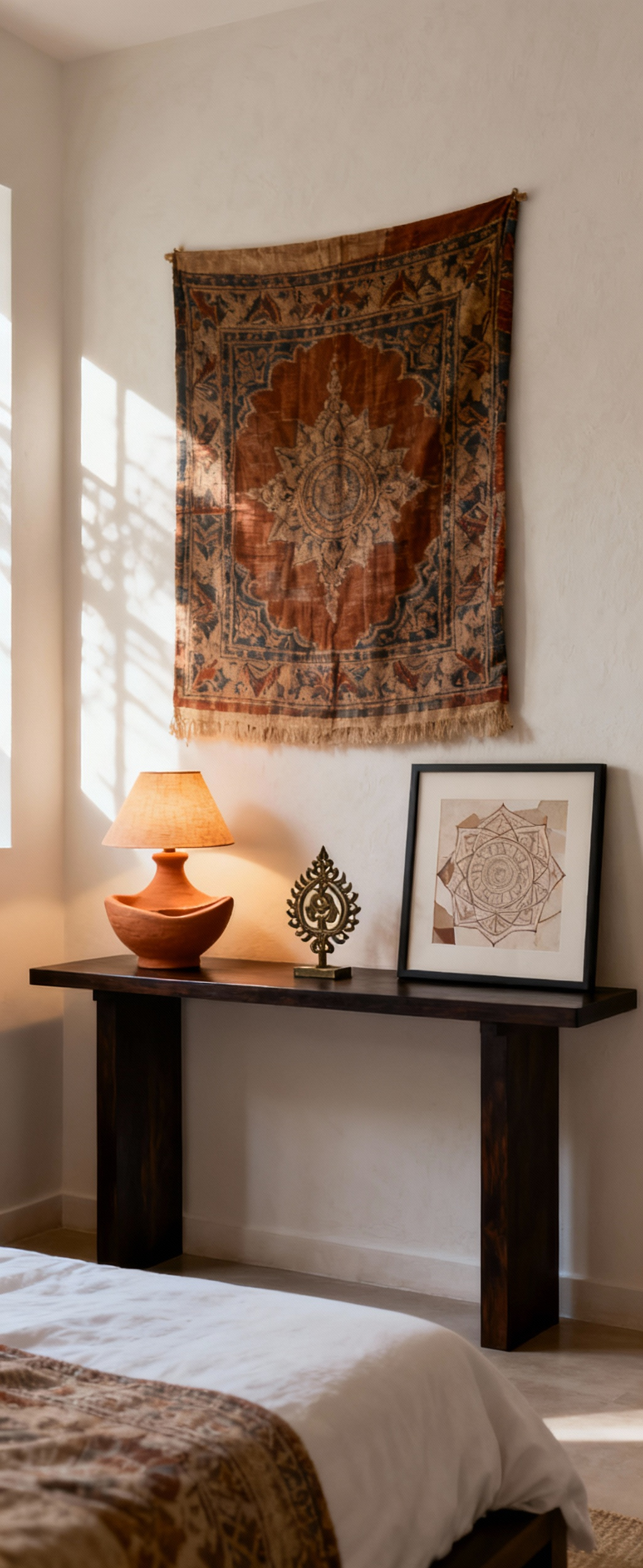
Perhaps it’s a small, antique bronze Nataraja statue you found in a dusty shop in Chennai, now sitting thoughtfully on your dresser. Or a collection of black-and-white photos of your grandparents, arranged artfully on a floating shelf. I learned this when I helped a client frame a piece of her mother’s wedding sari—a beautiful but worn silk brocade. Hung on the wall, it became the heart of the room, a radiant testament to her family’s history. These aren’t just decorations. They are anchors of identity. By carefully curating these personal motifs, you’re creating a space that doesn’t just reflect you; it nourishes your very soul, reminding you of the rich narrative that is yours alone.
Weaving Narratives: Advanced Embellishments and Functional Artistry (Part 1)
With our foundations firmly in place, it’s time for the flourish, the magic that brings a room to life. Here, we explore the exquisite details and artisanal pieces that transform a bedroom into a breathtaking narrative. This is where craftsmanship, artistry, and function intertwine to create a space that sings with personality and soul.
6. Harness Bespoke Textile Artistry with Hand-Block Printed Silks or Embroidered Velvets
Textiles are the soul of Indian design. They are not mere accessories; they are the storytellers, the keepers of generational skill, the very heartbeat of a room. For an immediate infusion of artistry, nothing compares to the bespoke beauty of hand-worked fabrics. Imagine dressing your bed in silks from Rajasthan, each motif painstakingly pressed onto the fabric using hand-carved wooden blocks. The slight imperfections are not flaws—they are the signature of the human hand, a whisper from the artisan who created it.
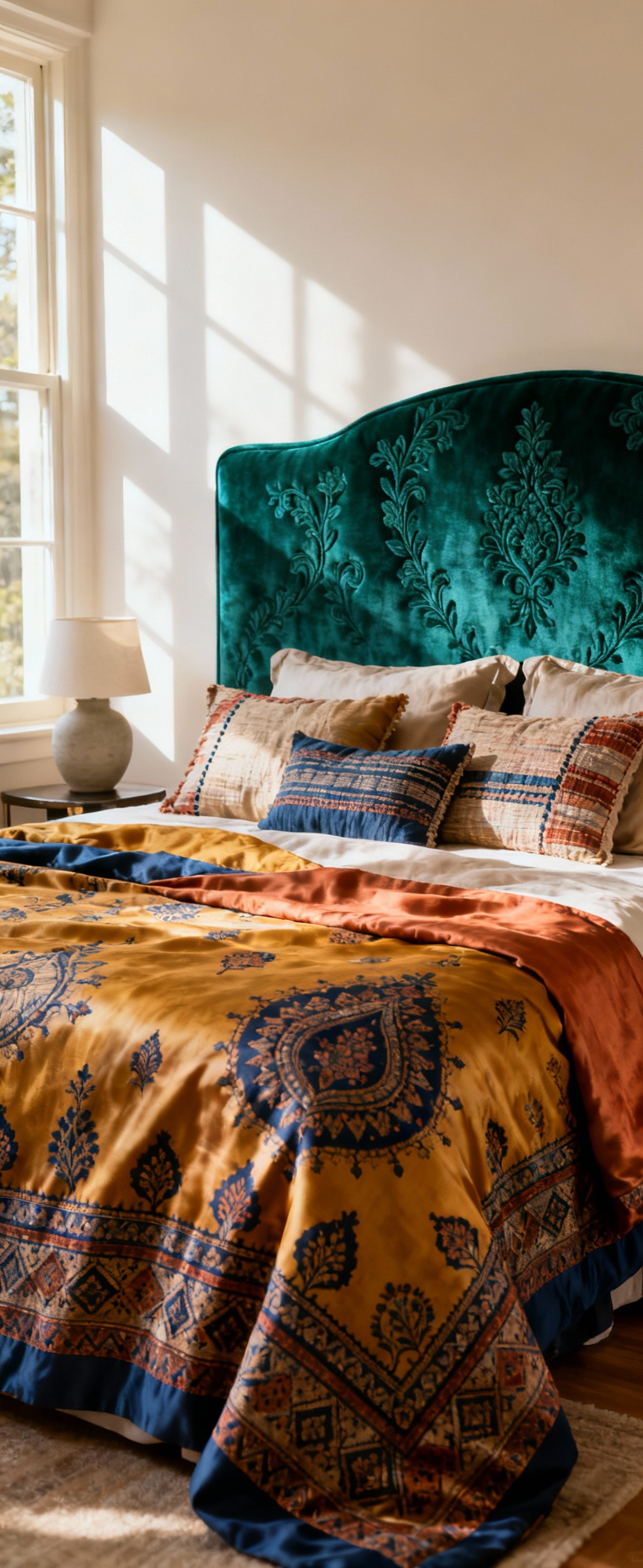
Or, for a touch of regal opulence, consider embroidered velvets. I am endlessly inspired by zardozi, a magnificent embroidery technique that uses metallic threads to create shimmering patterns reminiscent of Mughal court life. A headboard upholstered in deep emerald velvet with delicate gold zardozi work, or even just a pair of jewel-toned velvet cushions, can instantly elevate the room, lending it a sense of history and grandeur. What I always tell my readers is to choose one hero textile—a stunning quilt, a dramatic wall hanging, or a pair of breathtaking curtains—and let it be the star. These pieces are more than just decor; they are heirlooms in the making.
7. Deploy Architectural Lighting as Focal Sculpture to Define Ambience
Think of lighting as the jewelry of your room. It should do more than just illuminate; it should captivate, create drama, and sculpt the very atmosphere. Moving beyond basic lamps, architectural lighting acts as a focal point, an art piece in its own right. Instead of a standard ceiling fixture, why not a magnificent chandelier made of hand-beaten brass, its intricate filigree casting dancing, jali-like shadows across the room? Or a cluster of hand-blown glass pendants that shimmer like jewels?
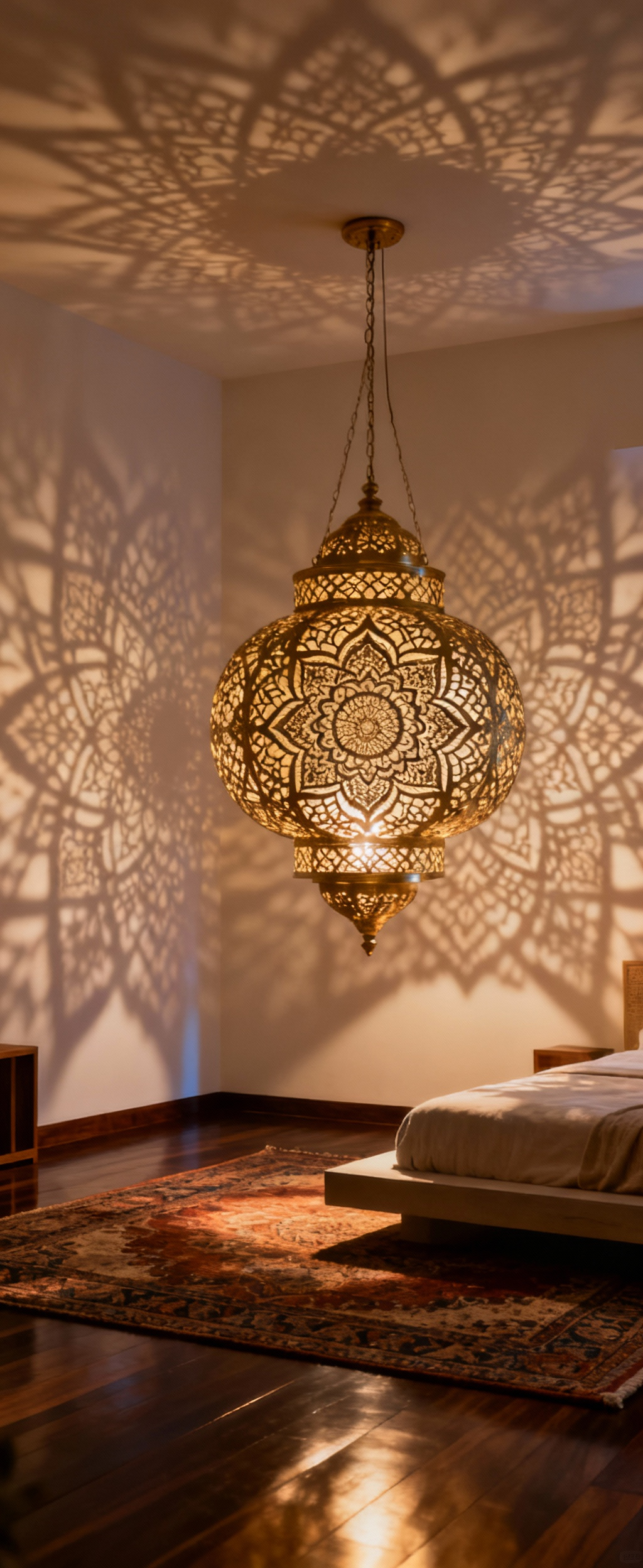
The layering is what creates the magic. Subtle cove lighting can wash a ceiling in a soft, ethereal glow, making the room feel more expansive. Beautifully crafted wall sconces flanking a piece of art not only highlight the work but also add a gentle, ambient layer of light. One of my favorite techniques is to place an uplight behind a large plant or a sheer silk curtain, transforming it into a living sculpture of light and shadow. When you begin to see light as a material to be shaped and curated, you unlock a whole new dimension of design, creating a space that feels dynamic, alive, and endlessly enchanting.
8. Adorn with Curated Ethnographic Artifacts: Storytelling Through Objets d’art
Let’s distinguish between decoration and curation. Decorating is filling space. Curation is filling space with meaning. Adorning your bedroom with ethnographic artifacts—objects rich with history and culture—is how you create a space that feels intelligent, soulful, and deeply personal. This isn’t about creating clutter; it’s about choosing a few pieces that speak to you, objects that have a story to tell.
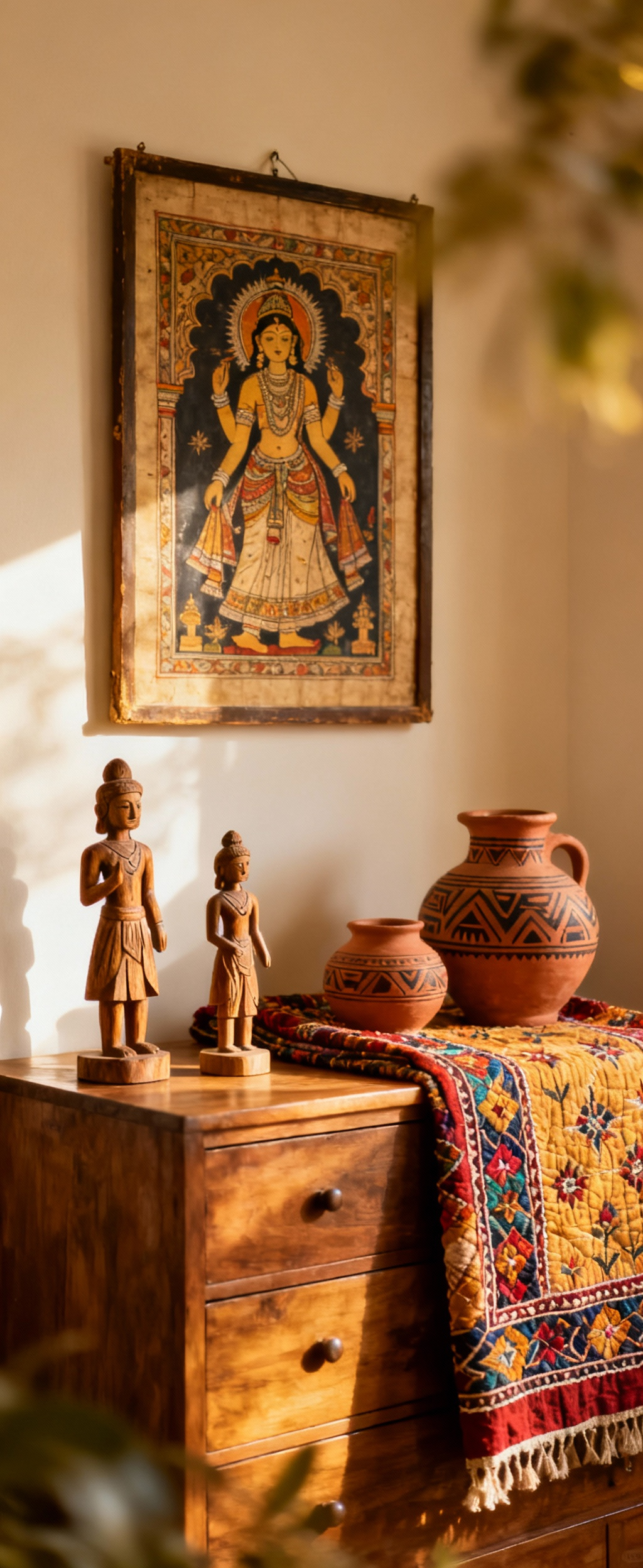
Maybe it’s a set of antique wooden printing blocks from Gujarat, now displayed as sculptural objects on a shelf. Or a finely carved temple pillar fragment, repurposed as a stand for a beautiful plant. Even small things can have a powerful presence, like a traditional Bidriware box with its striking silver inlay, used to hold your most treasured jewelry. These pieces bring a sense of history and authenticity that no mass-produced item ever could. You’re creating a private gallery, a collection that reflects your passions and travels. This thoughtful approach transforms your bedroom from a simple room into a rich repository of culture and story.
9. Master the Art of Symphonic Pattern Play without Overwhelming the Senses
Pattern is the rhythm of Indian design—it’s energetic, expressive, and full of life. But I know that for many, mixing patterns can feel intimidating. The secret to a successful, symphonic blend is to think like a composer, creating harmony through variation in scale, color, and motif. Start with a lead instrument: your “hero” pattern. This could be a large-scale floral or paisley on your duvet or an area rug. This piece sets the tone and the primary color story.
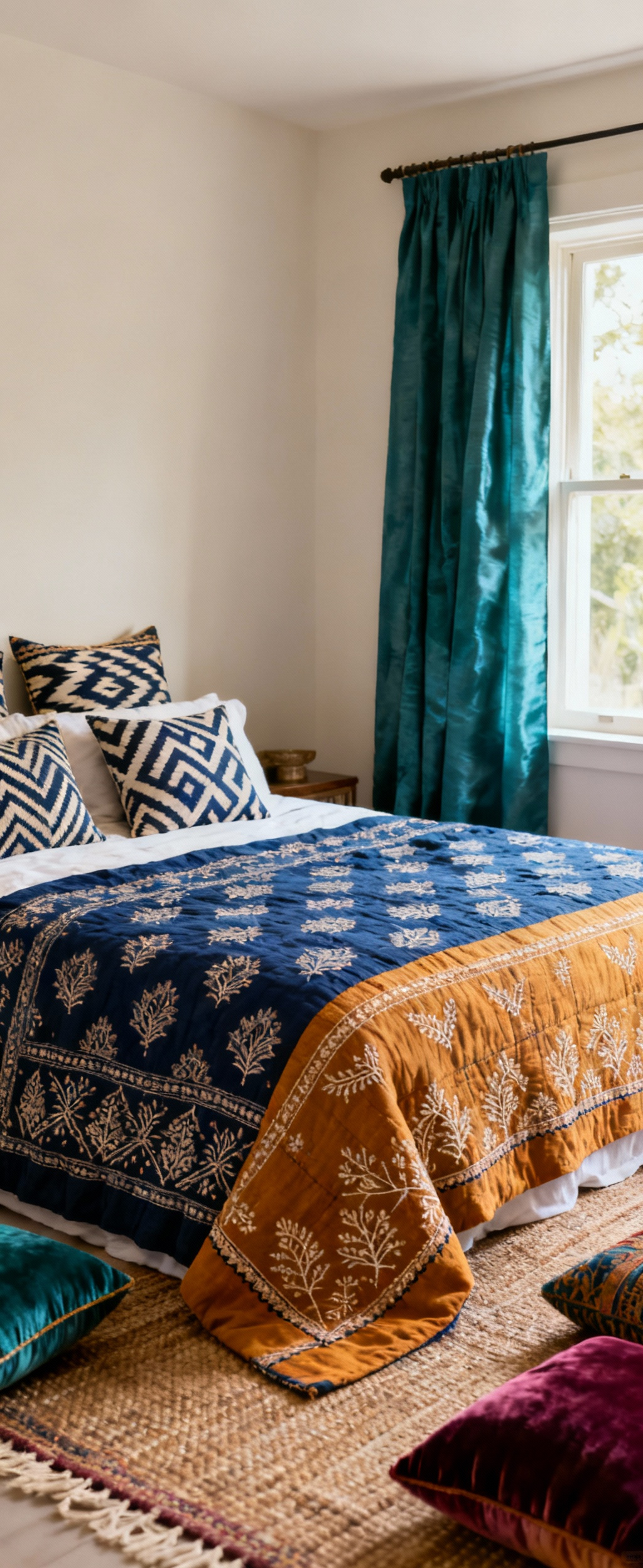
Now, bring in the supporting players. Pair your large floral with smaller, geometric prints on your pillows. Juxtapose a flowing, organic motif with a crisp stripe. The contrast in scale is what makes it work. The other unifying element is color. As long as your patterns share a common color palette—a thread of deep indigo, a flash of marigold, a base of soft cream—they will feel connected, not chaotic. Finally, remember to include moments of rest for the eye: a solid velvet cushion, a simple linen throw, or an unadorned wall. This is how you create a space that is visually rich and stimulating, yet ultimately feels balanced and serene. It’s a joyful dance of patterns, perfectly choreographed.
Weaving Narratives: Advanced Embellishments and Functional Artistry (Part 2)
As our narrative deepens, we look to pieces that are both show-stoppingly beautiful and brilliantly functional. This is about investing in statement items and clever solutions that anchor the room’s design, tell a powerful story, and make your sanctuary a joy to live in every single day.
10. Elevate the Central Vista with Artisanal Headboard Statements as Room Anchors
The bed is the heart of the bedroom, and the headboard is its crown. It’s the definitive anchor, the first thing your eye is drawn to, and a spectacular opportunity to make a powerful design statement. Forget mundane, off-the-shelf options. Think of your headboard as a piece of functional art. A grand, hand-carved wooden headboard inspired by the intricate jharokhas (enclosed balconies) of a Rajasthani palace can instantly transport you. The artistry, the sheer hours of skilled work—it’s a story in itself.
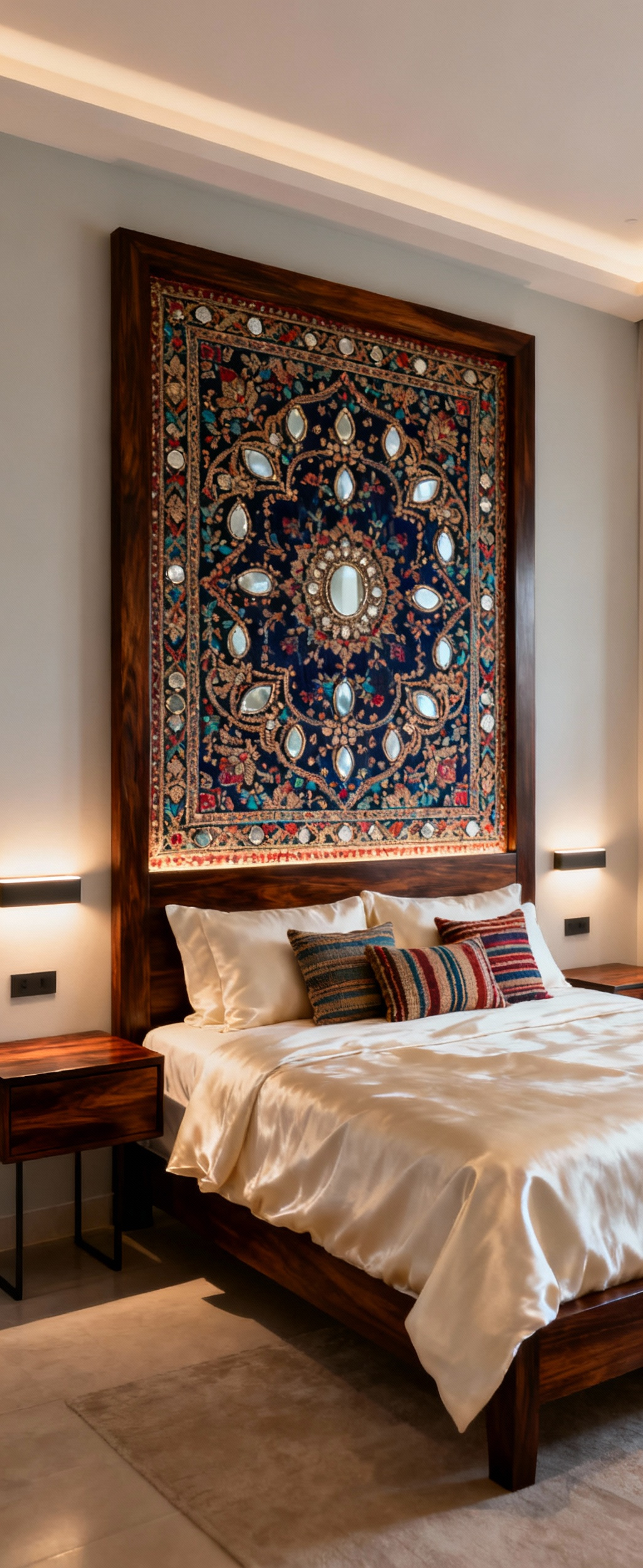
Years of Indo-contemporary fusion have taught me that old can be made thrillingly new. Repurposing an antique door or an architectural screen as a headboard is one of my favorite ways to infuse a room with instant soul and history. Or, for a softer but no less dramatic touch, a custom-upholstered headboard in a stunning fabric—perhaps a vibrant hand-blocked print or a sumptuous raw silk—offers incredible visual and tactile luxury. This single, deliberate choice can define the entire character of your room, transforming it from a simple bedroom into a truly majestic sanctuary.
11. Forge Ergonomic Elegance with Custom Millwork and Integrated Storage Solutions
True luxury is a space that works effortlessly. In a sanctuary dedicated to rest, clutter is the enemy of calm. This is where custom millwork becomes your greatest ally, offering bespoke storage solutions that are both beautiful and brilliantly practical. It’s about creating a seamless environment where everything has its place, allowing for an atmosphere of serene order.
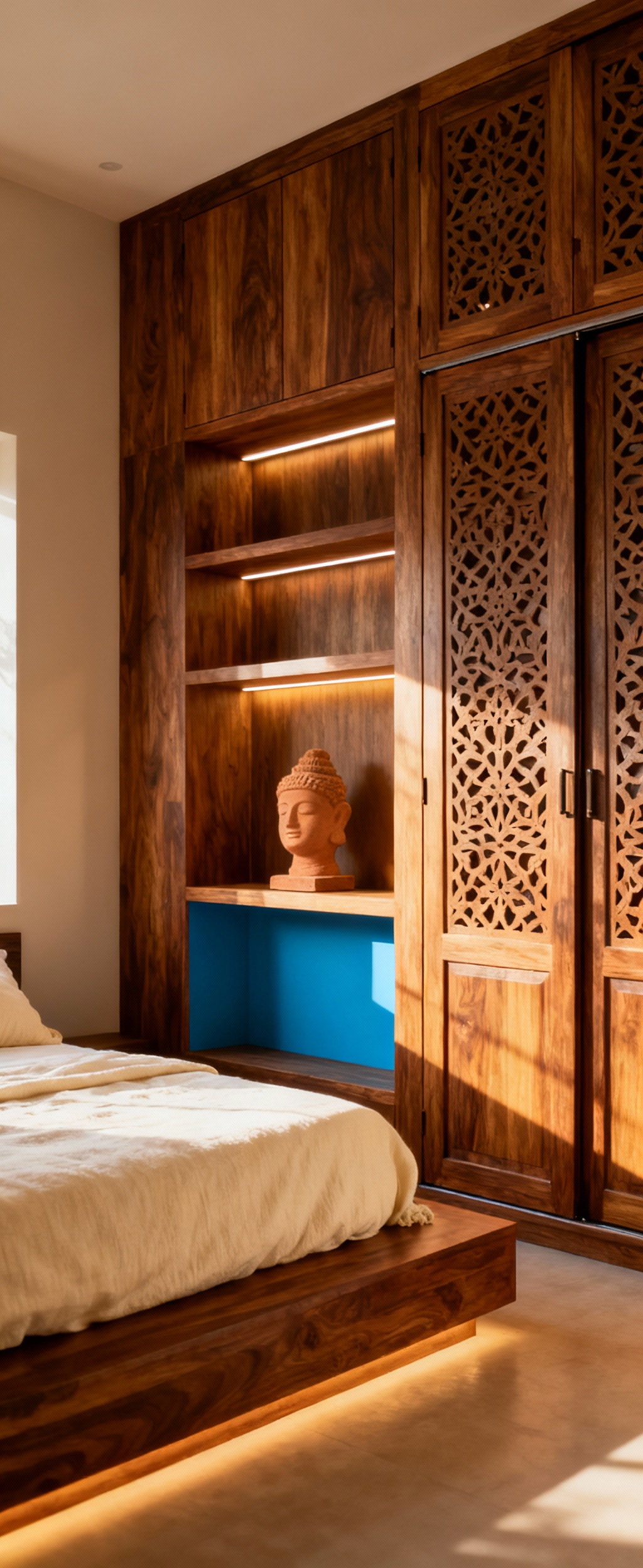
Imagine floor-to-ceiling wardrobes, their doors adorned with delicate jali fretwork that is not only beautiful but also allows clothes to breathe. Or a custom window seat, a perfect nook for reading, with deep, concealed drawers beneath for extra linens. My professional experience shows that these integrated solutions feel so much more intentional and sophisticated than a collection of mismatched freestanding furniture. The headboard can become a hub of clever storage, with hidden niches for books or integrated charging stations. When functionality is this beautifully designed, it becomes an art form, allowing you to maintain a space of pristine tranquility.
Revered Paradigms: Transmuting Global Cultural Archetypes into Contemporary Comfort (Part 1)
Now, let’s cast our net wider and draw inspiration from timeless design philosophies around the globe. This isn’t about mimicry; it’s about a respectful dialogue. By understanding the essence of these revered paradigms, we can distill their wisdom and translate it into a contemporary sanctuary that feels both globally informed and deeply personal.
12. Evoke the Moghul Chahar Bagh Symmetry for Harmonious Flow and Visual Balance
The Mughals were masters of creating paradise on earth, and their garden design philosophy, the Chahar Bagh, offers a brilliant blueprint for creating harmony in the bedroom. This principle is all about serene, formal symmetry, with a central point from which everything else flows in balanced harmony. In your room, the bed becomes this central axis. From there, you create a sense of graceful order by mirroring elements. Think identical nightstands, matching lamps, and perhaps a pair of elegant armchairs.
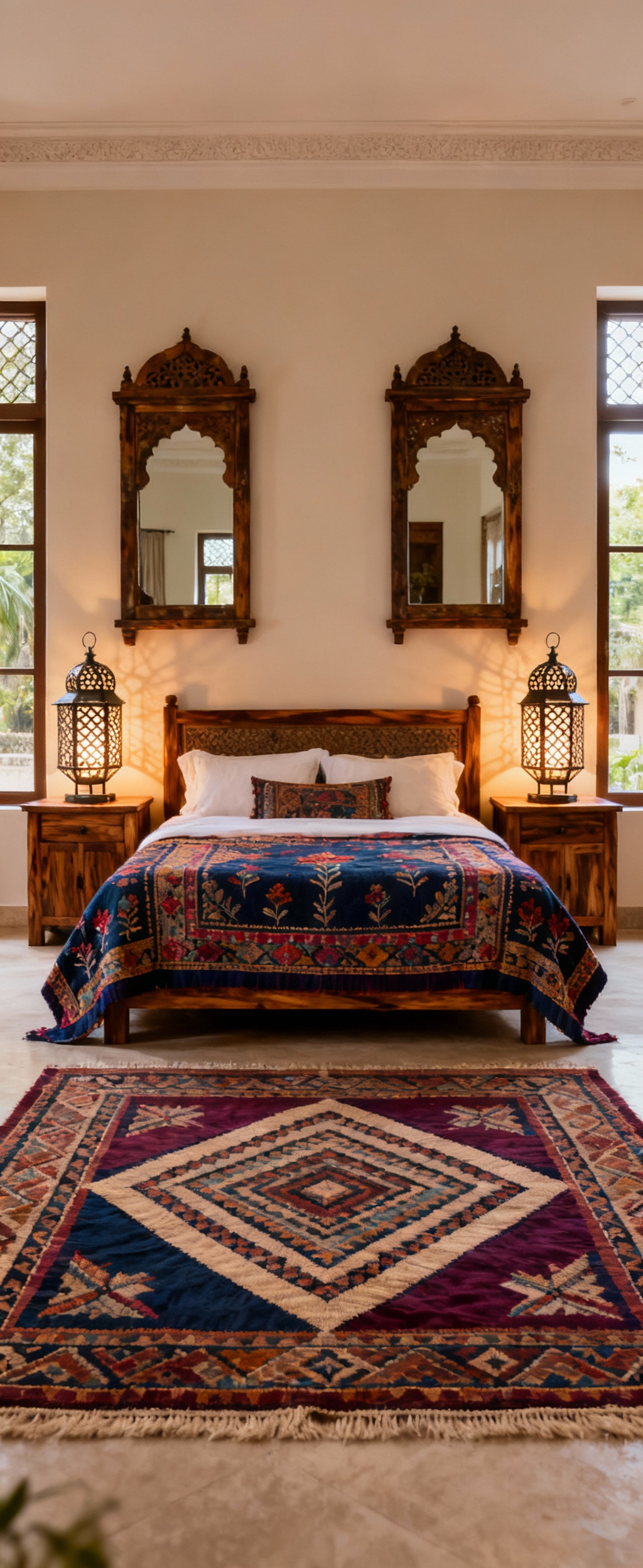
This doesn’t have to be rigid or stuffy. You can evoke the spirit of the Chahar Bagh through color and texture—layering jewel-toned silks and velvets, and incorporating furniture with intricate inlay or carved details. Reflective surfaces, like a beautiful mirror or brass accents, can mimic the shimmering water channels found in Mughal gardens, adding life and light. By applying this principle of intentional balance, you create a visual rhythm that is incredibly soothing to the eye, making the entire room feel stately, grounded, and profoundly peaceful.
13. Translate Nordic Hygge into Layered Serenity for Utmost Coziness and Comfort
While seemingly a world away, the Danish concept of Hygge—that feeling of profound coziness and contentment—shares a deep kinship with the spirit of sanctuary we aim to create. It translates beautifully into a bedroom that feels like a warm, loving embrace. The key is an obsessive focus on tactile layers, soft lighting, and natural materials.
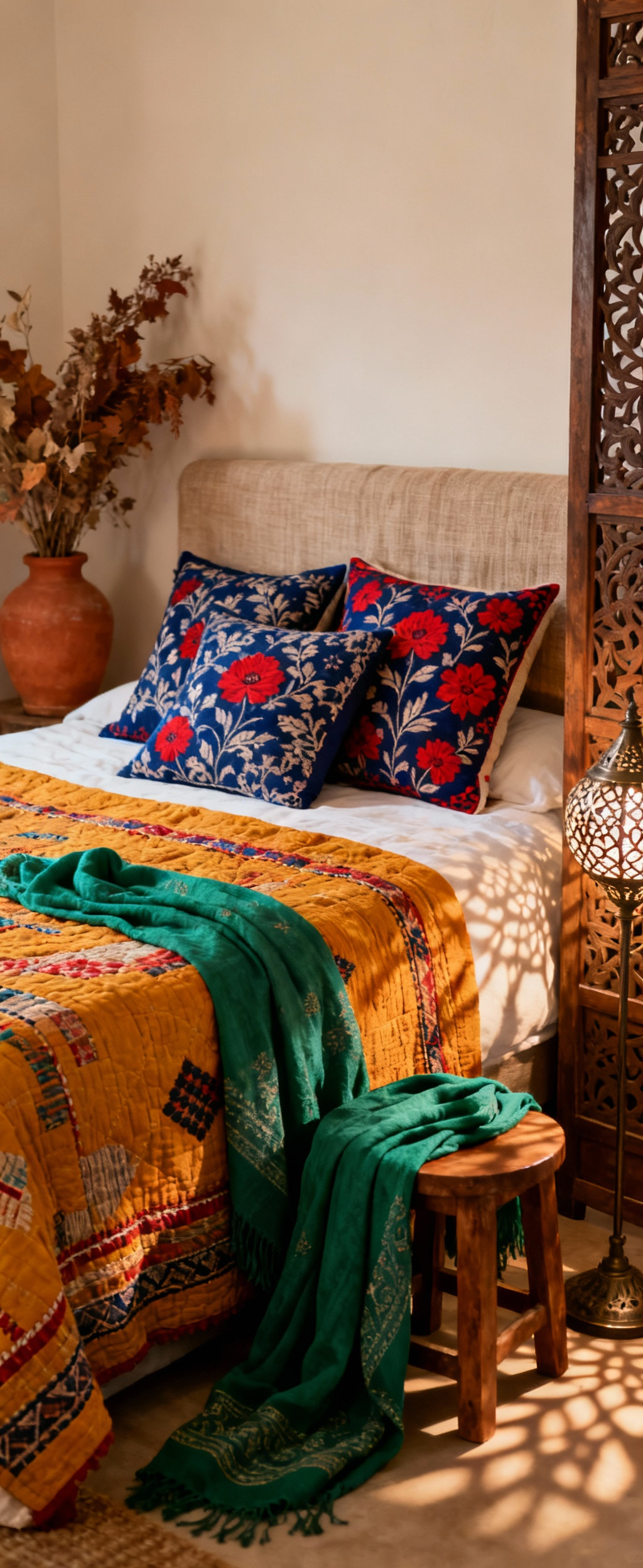
Start with a mountain of plush textiles on the bed: linen sheets, a chunky wool throw, velvet cushions. Place a wonderfully soft sheepskin rug where your feet will land in the morning. Natural elements are essential—furniture in light-toned wood, a handcrafted ceramic vase, and plenty of green plants to bring life indoors. And lighting? It’s absolutely crucial. Banish harsh overhead lights in favor of multiple, warm, and gentle light sources. And candles. Lots of candles. Creating a Hygge environment is about mindfully curating an atmosphere of comfort and simple pleasure, a perfect complement to a vibrant, cultured home.
14. Infuse Japanese Wabi-Sabi Minimalism for Poetic Imperfection and Organic Texture
There is so much beauty to be found in imperfection. The Japanese philosophy of Wabi-Sabi celebrates just that—the elegance of the incomplete, the transient, and the humble. Infusing your bedroom with this spirit means letting go of the need for polished perfection and instead finding beauty in natural materials, subtle textures, and things that show their age with grace.
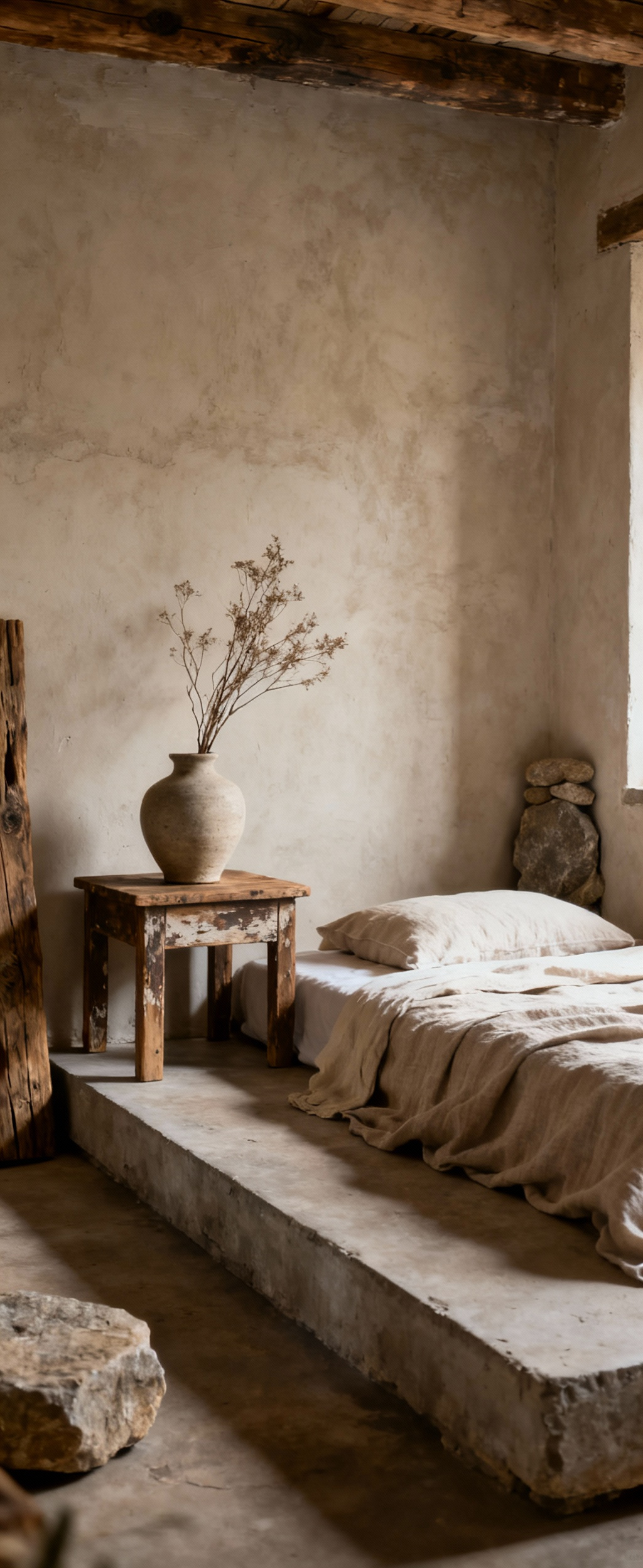
Think of a beautifully rumpled set of linen sheets, a handcrafted ceramic bowl with a slightly uneven glaze, or a piece of weathered, unfinished wood. The color palette is earthy and subdued—drawn from stone, clay, and bark. Minimalism here isn’t about stark emptiness; it’s about clearing away the non-essential to allow a few, carefully chosen, meaningful objects to truly shine. What I’ve noticed is that spaces designed with a Wabi-Sabi sensibility have a deep, quiet power. They invite you to slow down, to appreciate the simple and authentic, and to find peace in a world that is constantly chasing the new.
15. Channel Mediterranean Textural Richness with Sun-Drenched Hues and Earthy Finishes
Let’s invite the warmth and easy elegance of the Mediterranean coast into our sanctuary. This aesthetic is all about texture, natural materials, and a color palette that feels sun-bleached and earth-kissed. It’s a style that feels both rustic and incredibly chic, evoking a sense of relaxed, joyful living. Imagine walls with the rough, tactile finish of plaster, floors of cool terracotta, and sturdy furniture made from weathered, robust wood.
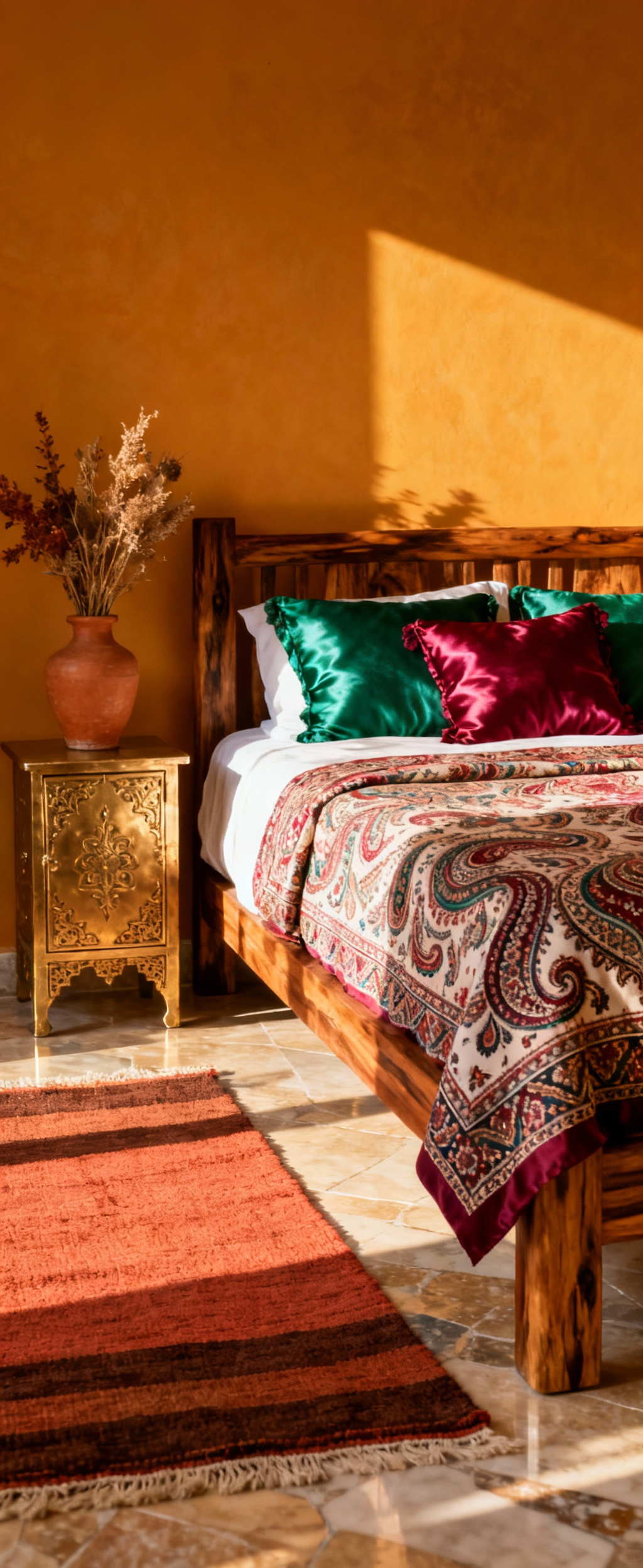
The colors are drawn from the landscape: the crisp white of a Greek village, the deep blue of the Aegean Sea, the warm terracotta of the soil, and the olive green of the groves. Soften these earthy elements with breezy, natural textiles like linen and cotton. Keep window treatments simple to let the light pour in. Accessorize with handcrafted pottery and maybe a single, beautiful olive tree in a large terracotta pot. It’s an aesthetic that is honest, grounded, and effortlessly beautiful, creating a bedroom that feels like a permanent holiday escape.
Revered Paradigms: Transmuting Global Cultural Archetypes into Contemporary Comfort (Part 2)
We continue our global design pilgrimage, exploring another powerful archetype. By understanding its core spirit, we can borrow its best ideas and weave them into our own unique cultural tapestry, creating a sanctuary that is layered, spirited, and utterly one-of-a-kind.
16. Embrace Bohemian Rhapsody with Calculated Abandon for a Spirited, Eclectic Sanctuary
A Bohemian bedroom is a love letter to a life richly lived. It’s a joyful, free-spirited collection of treasures from travels, beloved artworks, and an abundance of lush textiles. But true Bohemian style is not about chaos; it’s about calculated abandon. It’s a curated and artful eclecticism, a symphony of color, pattern, and texture that is held together by your unique personal story.
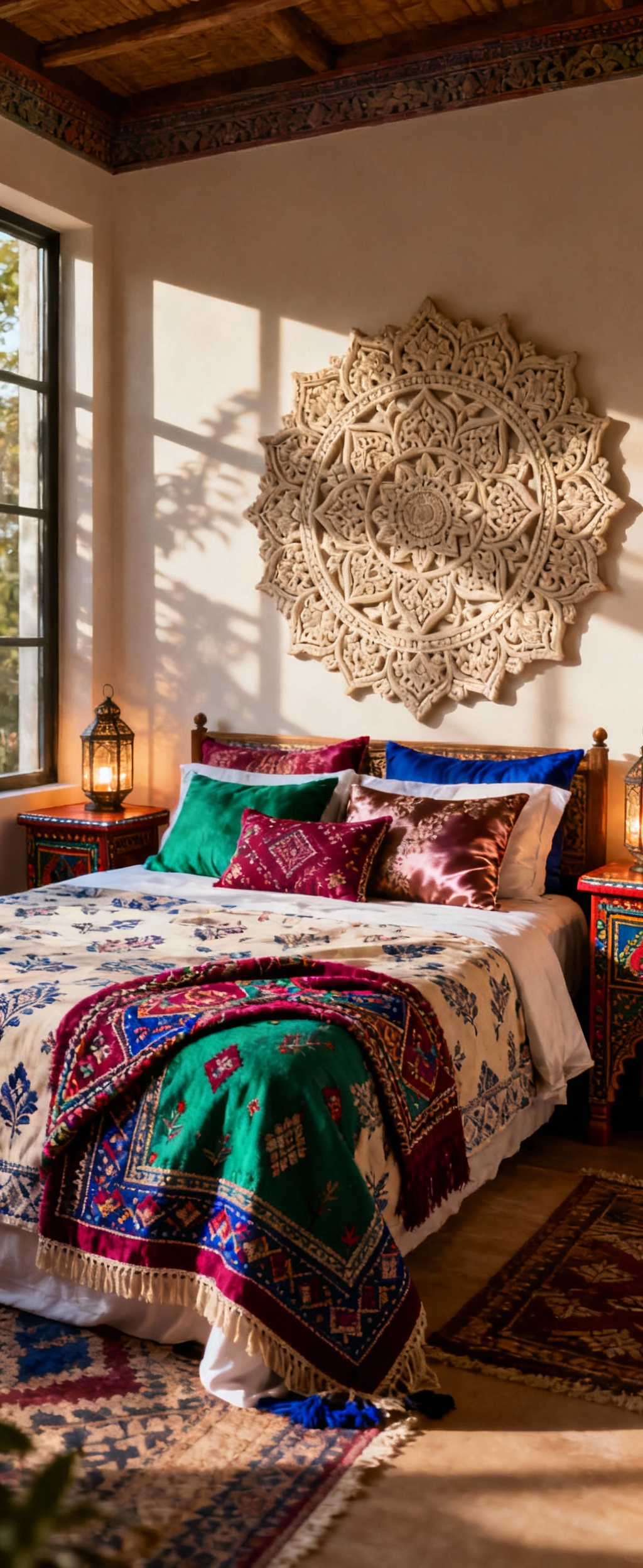
Layer, layer, layer! Pile on hand-blocked quilts, vintage Kilim rugs, and embroidered cushions. Mix patterns with fearless confidence. Let plants tumble from macramé hangers and grow wild from woven baskets. Light the space with Moroccan lanterns and fairy lights to create a magical, intimate glow. There are no strict rules here, only an invitation to express yourself fully. This is your personal oasis, a vibrant, soulful sanctuary that celebrates creativity, individuality, and the beauty of a world of inspiration.
The Epistemology of Sanctuary: Mindful Intent and Enduring Legacy
In our final exploration, we move beyond the physical and into the philosophical. What transforms a room into a true sanctuary? It’s the intention we bring to it, the stories we embed within it, and the legacy we hope to create. This is about designing a space that not only supports our present but also honors our past and invests in our future.
17. Consecrate Your Space Through Intention: The Psychology of Placement and Personal Narrative
The most beautiful rooms are consecrated with intention. This is the profound act of imbuing your space with meaning, turning it from a mere collection of objects into a sacred personal ecosystem. It’s about understanding the psychology of placement—how arranging furniture can either create harmony or discord—and using that knowledge to build a room that supports your well-being. This is where your personal narrative becomes the most important design tool.
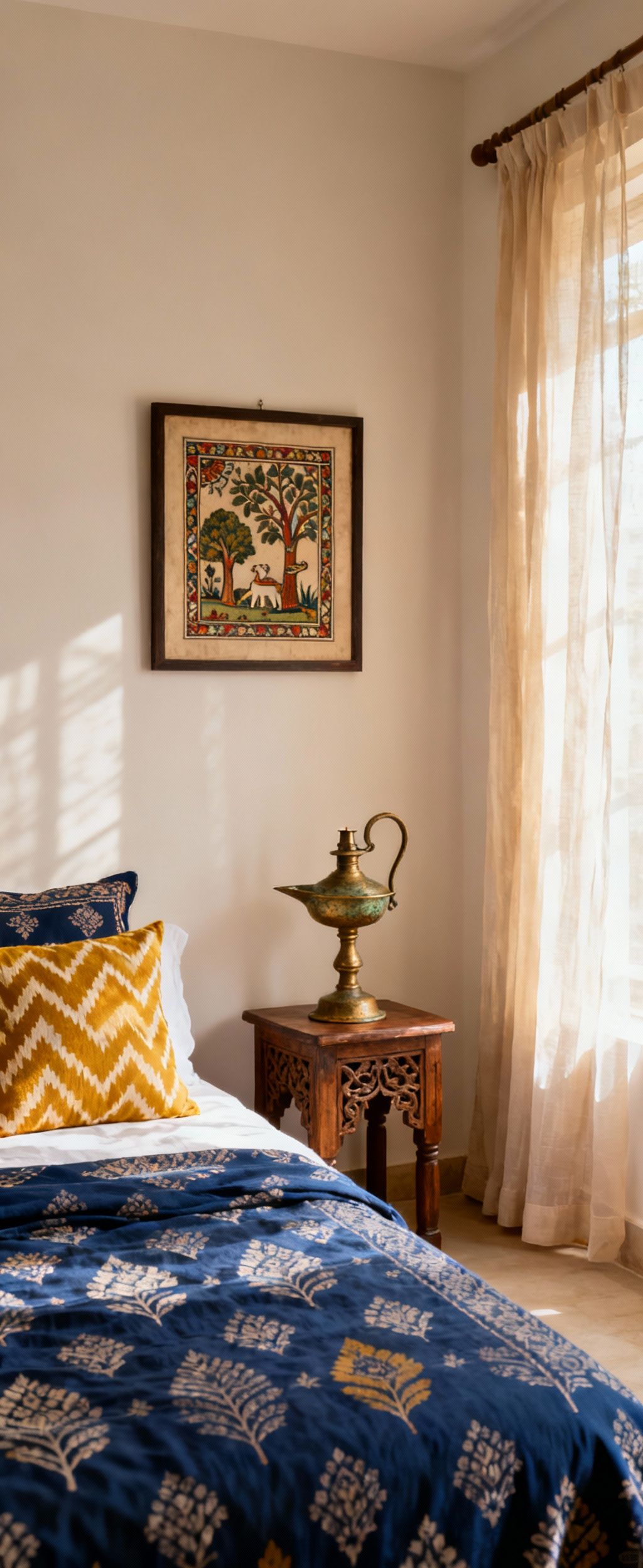
Every object you choose to bring into your sanctuary should have a purpose or a story. That small, hand-carved box isn’t just a box; it holds the memory of the journey you took to find it. Those textiles aren’t just fabric; they were passed down from your grandmother. When your space is filled with these meaningful touchstones, it becomes a constant source of affirmation and comfort. You are literally surrounding yourself with your own story, creating a powerful energetic field of belonging and peace.
18. Cultivate Enduring Heirloom Pieces for Longevity and Sustained Aesthetic Value
In a world of fast furniture and disposable trends, there is a quiet power in choosing to invest in pieces that are built to last. Cultivating heirlooms for your bedroom is a deliberate act of creating legacy. These are objects of exceptional craftsmanship and timeless design—a solid teak four-poster bed, a hand-knotted Persian rug, a beautifully made antique chest—that will only grow more beautiful with age.
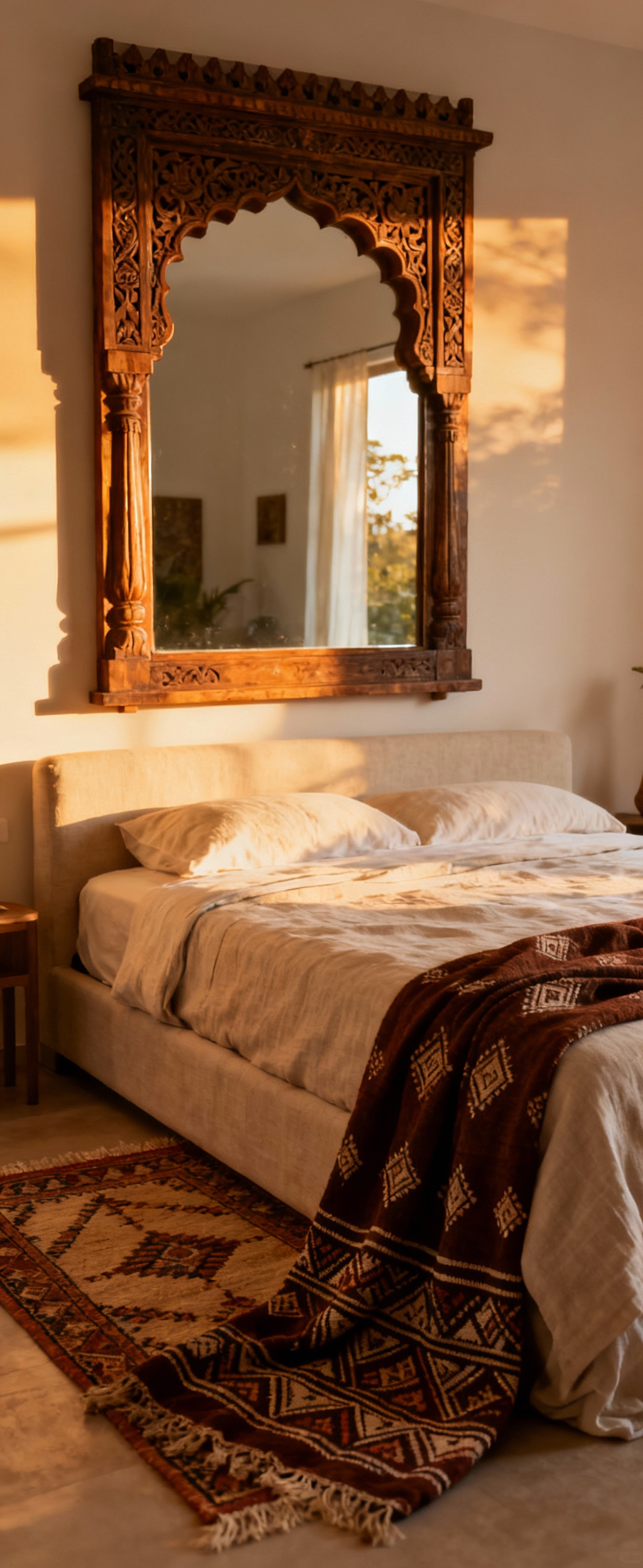
These pieces are the anchors of your room, imbuing it with a sense of gravitas and history. They tell a story of quality, of a reverence for materials and artistry. Choosing heirlooms is also a deeply sustainable act, a rejection of the throwaway culture. By investing in longevity, you are creating a sanctuary that feels substantial and timeless, a collection of treasures to be loved and passed down through generations. Your bedroom becomes a testament to enduring style and a repository of future memories.
19. Embrace Biophilic Integration for Organic Harmony and Vitality within the Enclave
We have an innate, primal need to connect with nature. Biophilia is the design philosophy that honors this connection, weaving the natural world into our indoor spaces to create environments that are healthier, happier, and more alive. In the bedroom, this goes beyond simply adding a plant or two. It’s a holistic approach to creating organic harmony.
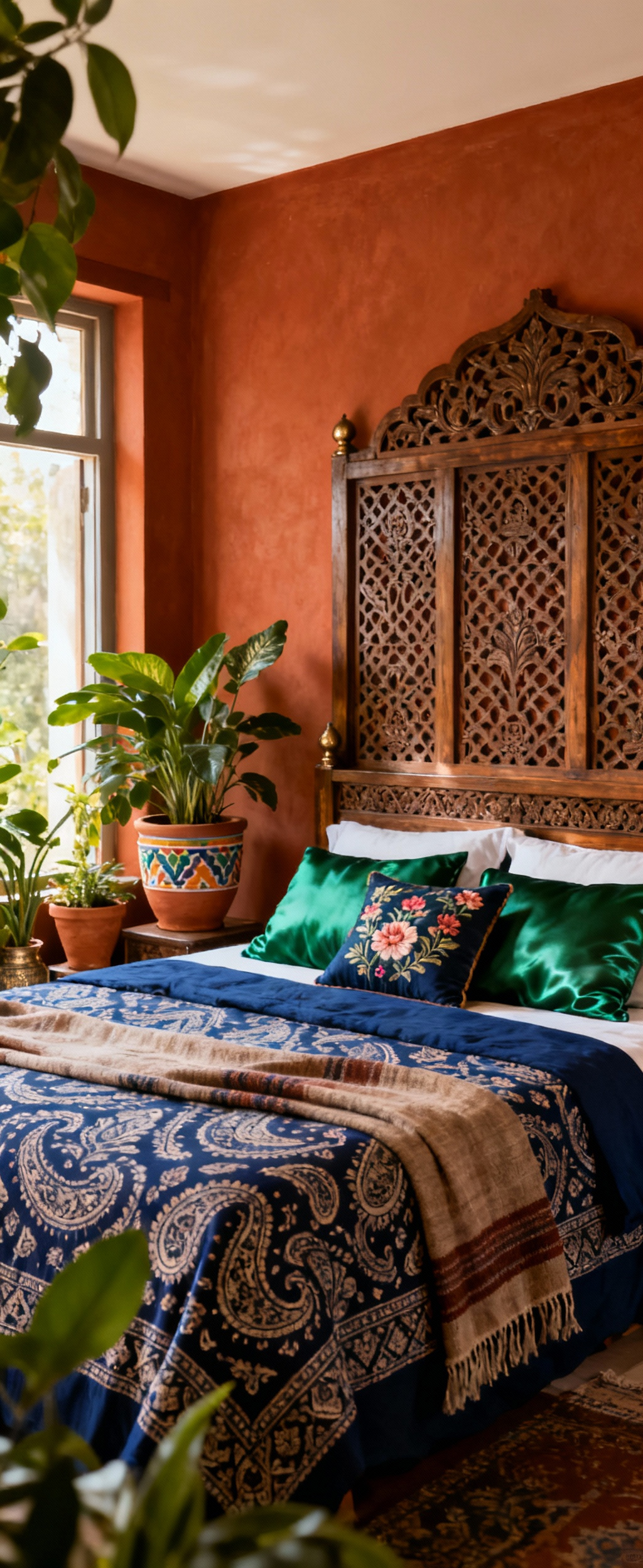
Maximize natural light. Use natural materials like wood, stone, and breathable fabrics like linen and cotton. Fill your space with thriving green plants that purify the air and delight the eye with their sculptural forms. You can even bring in nature-inspired patterns or artwork that evokes a sense of landscape and expanse. A biophilic bedroom is a sanctuary that breathes. It connects you to the life-affirming rhythms of the natural world, fostering a sense of vitality and deep, restorative calm.
20. Optimize Acoustics for Cerebral Quietude: Designing for True Sonic Tranquility
A true sanctuary must be a haven for all the senses, including our sense of hearing. We often forget how much ambient noise affects our stress levels and ability to rest. Designing for sonic tranquility is the final, crucial layer in creating a space of deep peace. This is about thoughtfully managing the acoustics of your room to create a quiet, cocoon-like atmosphere.
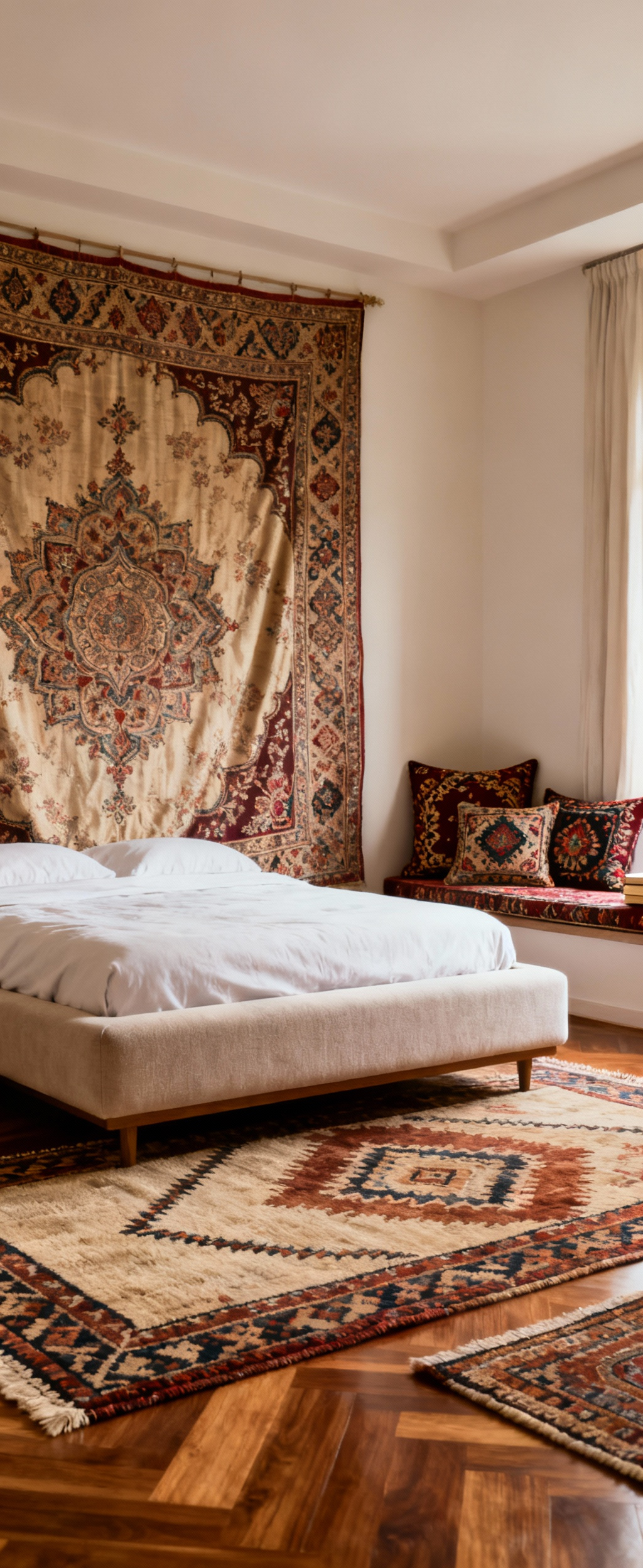
Soft surfaces are your best friend here. Plush rugs, heavy curtains, an upholstered headboard, and layers of textiles on the bed all work to absorb sound and prevent echo. Even a beautiful fabric wall hanging can make a significant difference. You’re creating an environment that muffles the harsh sounds of the outside world, allowing your mind to truly quiet down. By consciously designing the soundscape of your room, you’re creating the ultimate luxury: a space of profound, cerebral quietude.
Conclusion
As our vibrant exploration of these 20 bedroom inspirations decor ideas comes to a close, what becomes beautifully clear is that creating a sanctuary is an act of storytelling. It’s a deeply personal journey of weaving together threads of heritage, artistry, and self-expression. We’ve seen how ancient principles and global aesthetics can come together, not in a cacophony, but in a glorious symphony of serenity, creating a space that feels both timeless and utterly contemporary.
The real magic happens when you move beyond simply decorating and begin to curate a space that truly resonates with your soul. Your bedroom should be more than just a beautiful room; it should be a celebration of your story, a haven that restores your spirit, and a vibrant testament to the rich cultural tapestry that inspires you. As you embark on this creative adventure, I encourage you to be bold, be joyful, and listen to the whispers of your own heart. Cultivate a sanctuary that is authentically, exquisitely you.
